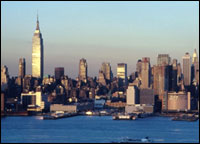In 1975, Ernest Callenbach published a slim book called Ecotopia, in which the Northwest secedes from the United States and establishes itself as an ecological paradise. The text became a counterculture classic, and the term “Ecotopia” entered the lexicon, embodying the American tendency to think of the continent’s forested far coast as a land of recycling bins and spotted owls, old-growth purity and environmental correctness.
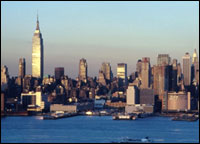
New Ecotopia?
But Callenbach was wrong, hindsight shows. On the most important criterion, New York City has a better claim to the title of Ecotopia than does the soggy region stretching north from San Francisco to the Canadian border.
Yes, the Northwest has cleaner air and water than the Big Apple, and an impressive share of its ecosystems still exist in something approximating their original state, which cannot be said of New York. Yes, Northwesterners generate 40 percent less trash than New Yorkers and recycle more of it — a gap that will widen now that Gotham has gutted its recycling program. (Callenbach was right about “the rigid practices of recycling and reuse upon which Ecotopians are said to pride themselves so fiercely.”) And Northwesterners are more frugal with water: The residents of greater Portland, Ore., consume a fifth less — and Seattleites a quarter less — water per person, despite the large, un-New Yorkish lawns they irrigate.
And there’s little contest when it comes to attitudes and activism. The Northwest has an attachment to nature and to outdoor pursuits perhaps unrivaled on the continent, and the region has been the proving ground for one environmental reform after another: Oregon’s 1971 bottle bill and 1972 land-use planning; Seattle’s pioneering efforts in energy conservation in 1975 and comprehensive curbside recycling program in 1988; the region’s protection of old-growth forests in the early 1990s; and, since the late 1990s, a full-fledged salmon recovery effort that blankets entire metropolitan areas.
But look at Northwesterners’ consumption of energy, the most significant environmental metric, and one that’s coupled to everything from dam-blocked salmon runs to collapsing Antarctic ice shelves, from the Exxon Valdez to Three Mile Island. Callenbach’s book describes a place that has pared its energy use to a minimum. But today the Northwest — including Idaho, Oregon, Washington, and British Columbia — uses one-third more energy per resident than does the state of New York. New York City residents use even less.
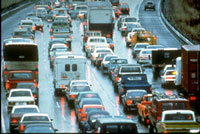
A typical commute in Seattle.
Photo: Washington State Department of Transportation.
The main difference in energy use relates to transportation. In Callenbach’s Ecotopia, there isn’t a gas station in sight. In the real, energy-dystopic Northwest, a typical resident burns more than three times as much gasoline per day as a typical New Yorker. The gas, of course, fuels motor vehicles, the principal polluters of local air and the fastest growing source of greenhouse gases. These climate-altering pollutants, in turn, are arguably the biggest environmental threat of the new century; stanching their release tops the planetary to-do list.
The five boroughs of New York City have one car or truck for every four residents; the Northwest has more than three times as many. In fact, the Northwest has more vehicles than licensed drivers. So much for “the Ecotopians’ abolition of cars.” Worse, Northwesterners are trading their cars for trucks, which burn more fuel, spew more heat-trapping emissions, and pose greater collision risks to other drivers and pedestrians. Oregon’s trucks, including minivans and SUVs, are likely to soon outnumber cars; in Idaho, they already do. But in New York state, just a quarter of all vehicles are trucks.
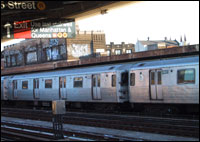
A train runs in Brooklyn.
The difference in driving rates is easy to explain: metropolitan New York is compact and well served by public transit; the Northwest sprawls. Studies of 68 cities on four continents show that as the population density of a neighborhoods rises, driving drops off, transit use surges, and walking and cycling flourish. More than any other factor, density is the key to reducing our dependence on motor vehicles. And New York is the New World’s density capital, which makes it the winningest city not only for baseball but also for transit and walking. Portland, the darling of the urban planning guild, and my hometown of Seattle both pale by comparison, as does even Vancouver, B.C., which is probably the densest city west of the Mississippi.
It’s true that New York City comes by its transit-friendly nature for reasons unrelated to, and perhaps antithetical to, environmental consciousness. The architects of the city’s density were unscrupulous real estate developers who held sway over city hall — an ecological triumph by accident. But the Northwest has also benefited from its share of historical and geographical flukes. Settled late by Old World migrants, the Northwest has fewer aging dumps, antiquated factories, and dirty boilers than New York. Its forests were plundered less thoroughly than those on the East Coast. And its air supply is buffered from Asian factories by the Pacific Ocean, while New Yorkers breathe the exhaust of power plants in the Midwest.
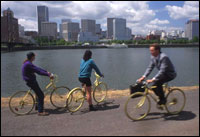
Pedaling toward a greener future in Portland.
So how can the Northwest become more like New York without becoming New York? Reducing our addiction to automobiles is paramount, and the most effective way to do this is to curb sprawl and make our cities more compact and friendlier to walkers, cyclists, and mass transit. We’ve already made progress in this area — witness the dramatic downtown growth and effective farmland protection policies of Vancouver, B.C. — but we need to implement other innovations, such as zoning and tax measures that do a better job of encouraging mixed-use neighborhoods and modest increases of density, and that better enforce our urban growth boundaries.
Policies aimed at making it easier for residents to drive less could also help. Oregon recently passed a bill encouraging insurers to offer pay-as-you-drive car insurance, which would reward consumers for trimming their mileage. Seattle’s Puget Sound Regional Council is test-driving congestion pricing, an innovative program that would make the price of driving reflect its true cost to society and the environment. Vancouver, B.C., which decided not to build a freeway through its downtown, offers many lessons in restraining the use of cars in the city.
Such efforts may help the region finally live up to its reputation as an ecological paradise. Until then, though, we Northwesterners with our cars and carbon dioxide will have to look east to find Callenbach’s imagined country. Ecotopia is on the Hudson.
